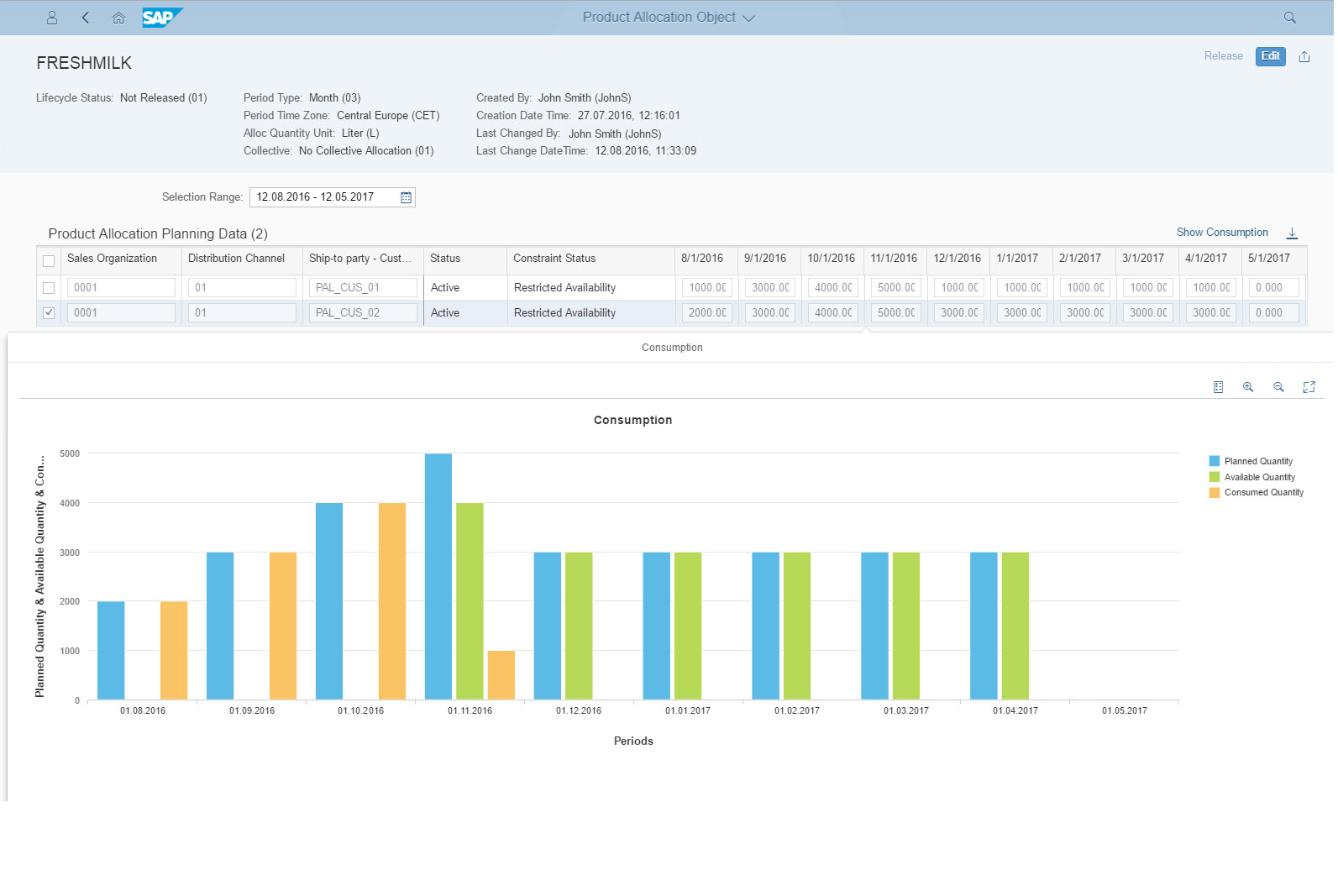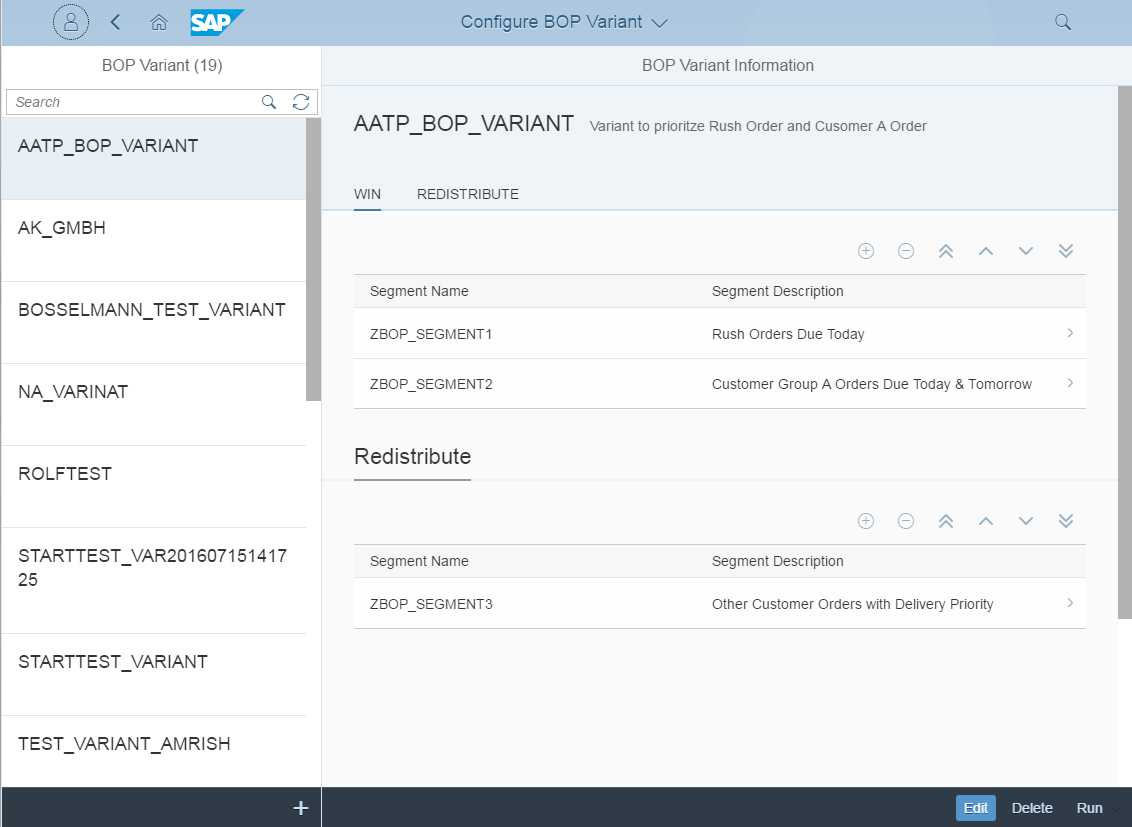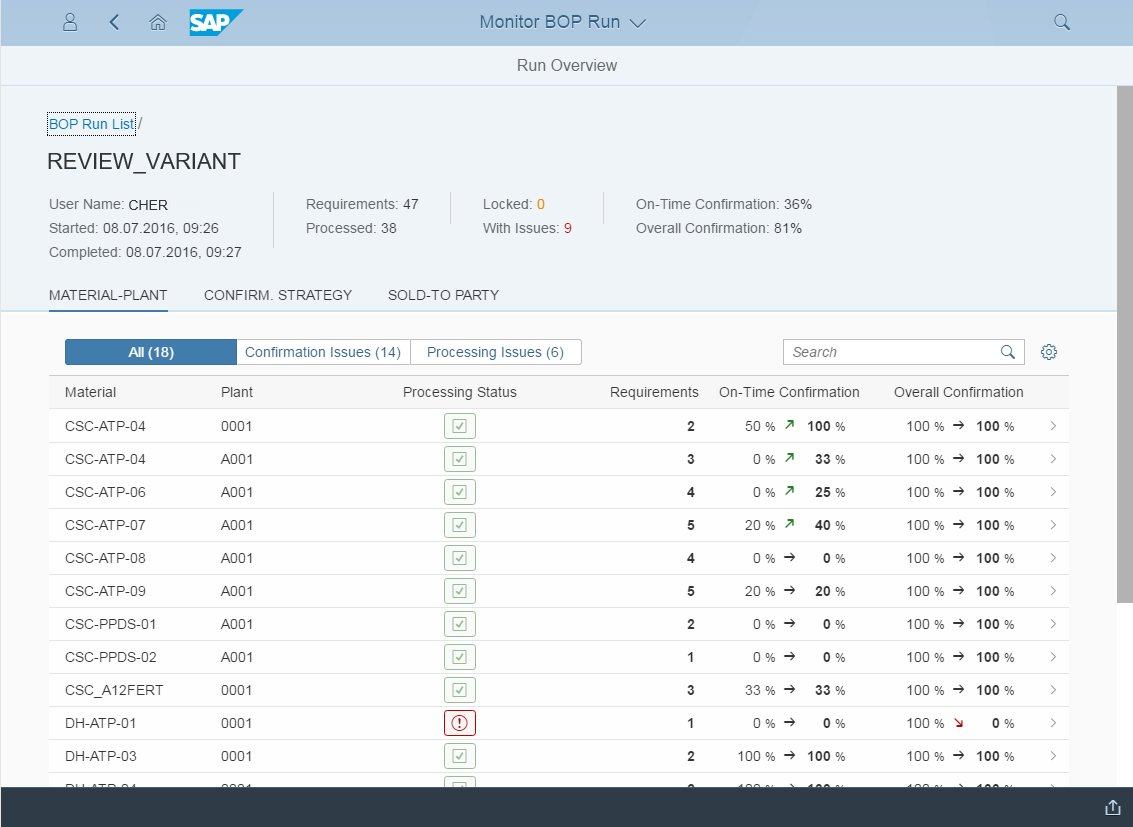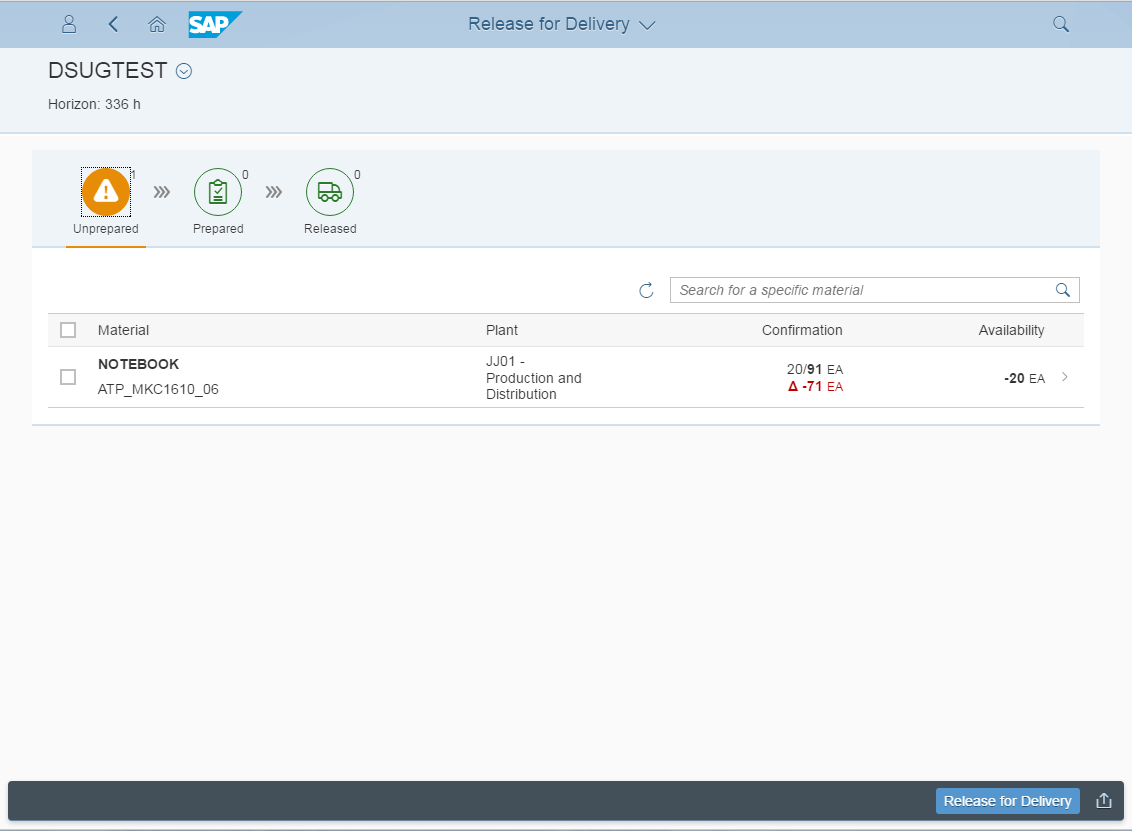
- SAP Community
- Products and Technology
- Enterprise Resource Planning
- ERP Blogs by Members
- Global Available to Promise as a part of S/4HANA 1...
Enterprise Resource Planning Blogs by Members
Gain new perspectives and knowledge about enterprise resource planning in blog posts from community members. Share your own comments and ERP insights today!
Turn on suggestions
Auto-suggest helps you quickly narrow down your search results by suggesting possible matches as you type.
Showing results for
rahul_agarwal5
Active Participant
Options
- Subscribe to RSS Feed
- Mark as New
- Mark as Read
- Bookmark
- Subscribe
- Printer Friendly Page
- Report Inappropriate Content
02-02-2017
10:54 PM
There have been many key innovation in the latest SAP S/4HANA 1610 suite in the core features of Finance & Logistics. In this blog I would like to focus on the ATP capability offered by S/4HANA 1610 & how we can be sure to call it Advanced Availabity to Promise or aATP & that can be a great option for clients who plan to have this core APO functionality with S/4HANA earlier known as gATP.
This blog should work as end to end source of knowledge on below areas relevant to aATP-
Primary business challenges which aATP targets are –
aATP Key Capabilities-
S/4HANA utilizes well the in-memory computing to find mass product availability for Sales, Planned & Production orders, giving business new levels of visibility.
Data and process innovations in back-order processing and sales product allocation
Product Allocation
Back-Order Processing
Business Benefits from aATP
What’s next – Future Road maps
SAP is planning key innovations further on below specific areas under aATP which we might see in coming time.
Set up aATP in S/4HANA 1610
To keep it simple most of the configuration will be in-line with the normal ATP setup i.e. Defining Requirements Classes, Maintaining Checking Groups, Defining Checking Rule, Carrying Out Control For Availability Check. Most of these are available under Best Practice documentation provided with the release documents.
Bonus as of 1610 – New aATP Fiori apps.
There are 7 apps which have been introduced to harness the aATP capabilities in S/4HANA & we will discuss each of them one by one.
With this app, one can create, find, display and change the schema for a product allocation object. The schema of a product allocation object comprises, among others, the ID and description of the product allocation object, periodicity, characteristics structure and their hierarchy, the unit of measure for the planned allocation quantity and the date time type (material availability date, good issue date and requested delivery date) used for the product allocation check.
Key Features

With this app, one can maintain characteristic value combinations and planned allocation quantities for the time periods of the characteristic value combinations. Characteristic value combinations and the corresponding time series can be maintained by uploading CSV files. This app also enables to change the activation status, the constraint status of the characteristic value combinations as well as the lifecycle status of the product allocation object.
Key Features

With this app, one can assign materials and material-plant combinations to product allocation objects that were created in the Configure Product Allocation app and for which one defined planning data in the Manage Product Allocation Planning Data app. The assignment activates availability checks against product allocation for sales order requirements for the assigned materials and material-plant combinations. The assignment of materials and material-plant combinations is time-dependent and enables user, for example, to react easily to temporary or seasonal fluctuations of supply and demand.
Key Features

With this app, one can define a set of rules with which to prioritize the distribution of supply when the demand for the materials in sales orders exceeds the available inventory or capacity. Using a combination of filters and prioritizers, you can automate rescheduling and redistribution in line with your company strategy.
User can use the "Configure BOP Variant" app subsequently to create a BOP variant and execute the corresponding backorder processing run either directly in the app or in the "Schedule BOP Run" app.
Key Features

With this app, one can define a variant for backorder processing (BOP), including an optional combination of filters and prioritizers, with which you can automate rescheduling and redistribution of materials in limited supply.
Results of the backorder processing run can be checked in the "Monitor BOP Run" app.
Key Features

With this app, one can display the results of backorder processing runs that have been setup in the "Configure BOP Variant" app. The app shows the confirmation status of requirements at different levels of granularity, helping user to confirm that the backorder processing runs complies with your company's strategy.
If the results of the backorder processing run are not as required, one can change the setup of the corresponding BOP variant and execute the run again. Alternatively, one can use the "Release for Delivery" app to adjust the confirmation data manually.
Key Features

With this app, one can prioritize due sales orders containing materials with limited availability in the order fulfillment responsibility to which user is assigned. The app allows one to view the material availability situation of materials for which he/she is responsible as well as assess the potential financial impact of being unable to fulfill sales orders. This, in combination with other factors, helps one decide how to distribute material quantities between sales orders, before he releases the sales orders for subsequent logistics processes.
Key Features

hope this proves helpful for the 1610 implementations pertaining to aATP.
This blog should work as end to end source of knowledge on below areas relevant to aATP-
- Business challenges
- Key Capabilities
- Business Benefits
- Future roadmap from SAP in this area.
- Set up aATP in S/4HANA 1610.
- Bonus as of 1610 – New aATP Fiori apps.
Primary business challenges which aATP targets are –
- Difficult to fulfill customer orders on time with the proper quantity.
- Inability to promise accurate and reliable order dates.
- Inefficient strategies to fulfill orders from the entire network or to substitute products automatically.
- Inefficient strategies to sell scarce products in a fair manner.
- Inefficient ways to manage order backlogs.
aATP Key Capabilities-
S/4HANA utilizes well the in-memory computing to find mass product availability for Sales, Planned & Production orders, giving business new levels of visibility.
- ATP check for all items of an order at once.
- Significant performance improvements for releasing large production orders.
Data and process innovations in back-order processing and sales product allocation
- New concept of confirmation strategy.
- Product allocation in SAP S/4HANA has a completely new design and implementation based on neither SAP ECC nor SAP Advanced Planning and Optimization application.
Product Allocation
- Supports the business decision if a sales order should be confirmed and, if yes, to which extent.
- aATP can be used for scarce product allocation based on almost any attribute of the underlying sales order, material, plant, or customer so that one can achieve maximum customer satisfaction as per set business rules.
- Grouping and aggregation capabilities (collective allocations) for simplification and ease of maintenance.
Back-Order Processing
- Back Order Processing can be completed easily via Fiori apps utilizing requirement classifications that helps to identify & fulfill most critical orders in timely manner.
- New concept for requirement classification, like winner, gainer, redistributor, filler, loser.
- New SAP Fiori app to display the BOP result–result is displayed on different aggregation levels and allows an easy identification of (and fast drill-down to) confirmation issues.
Business Benefits from aATP
- Fulfilling an order on time and in the desired quantity using different kind of checks for different business scenarios.
- Performing automatic back-order processing.
- Reducing inventory carrying cost.
What’s next – Future Road maps
SAP is planning key innovations further on below specific areas under aATP which we might see in coming time.
- Back Order Processing – BOP Analytics, Automatic exception handling (fallbacks), Provide extensibility features.
- Product Allocation - Extensibility and flexibility, Instance-based authorization, Alternative sources of supply, Analytics: explanation component, Modeling of constraints production and supplier capacity in multilevel scenarios, PAL for transportation and warehousing.
- Rules-based ATP (RBA) -Alternative plants (Determination of allowed alternatives, Mass check of allowed alternative plants, Selection of best-alternative plant). Integration of RBA result in SD sales order (Replace existing line item, Add additional sub items), Machine-learning capabilities in rules-based ATP.
Set up aATP in S/4HANA 1610
To keep it simple most of the configuration will be in-line with the normal ATP setup i.e. Defining Requirements Classes, Maintaining Checking Groups, Defining Checking Rule, Carrying Out Control For Availability Check. Most of these are available under Best Practice documentation provided with the release documents.
Bonus as of 1610 – New aATP Fiori apps.
There are 7 apps which have been introduced to harness the aATP capabilities in S/4HANA & we will discuss each of them one by one.
- Configure Product Allocation-
With this app, one can create, find, display and change the schema for a product allocation object. The schema of a product allocation object comprises, among others, the ID and description of the product allocation object, periodicity, characteristics structure and their hierarchy, the unit of measure for the planned allocation quantity and the date time type (material availability date, good issue date and requested delivery date) used for the product allocation check.
Key Features
- Create new product allocation objects.
- Search for, display and edit product allocation objects.
- Define the period types for product allocation objects.
- Define and order the characteristics for product allocation objects.
- Deactivate and delete product allocation objects and their characteristics

- Manage Product Allocation Planning Data
With this app, one can maintain characteristic value combinations and planned allocation quantities for the time periods of the characteristic value combinations. Characteristic value combinations and the corresponding time series can be maintained by uploading CSV files. This app also enables to change the activation status, the constraint status of the characteristic value combinations as well as the lifecycle status of the product allocation object.
Key Features
- Maintain characteristic value combinations and planned allocation quantities for their time periods.
- Use CSV files to maintain characteristic value combinations and their time series.
- Change the activation and constraint status of product allocation objects.
- Display the availability situation (planned, available and consumed quantity) for the materials in product allocation objects.
- Release product allocation objects and their planning data for productive usage.

- Assign Products to Product Allocation
With this app, one can assign materials and material-plant combinations to product allocation objects that were created in the Configure Product Allocation app and for which one defined planning data in the Manage Product Allocation Planning Data app. The assignment activates availability checks against product allocation for sales order requirements for the assigned materials and material-plant combinations. The assignment of materials and material-plant combinations is time-dependent and enables user, for example, to react easily to temporary or seasonal fluctuations of supply and demand.
Key Features
- Assign materials or material-plant combinations to product allocation objects.
- Define validity periods for any assignments.
- Define the consumption range (number of backward and forward consumption periods), consumption unit and allocation factor for the product location assignments.

- Configure BOP Segment
With this app, one can define a set of rules with which to prioritize the distribution of supply when the demand for the materials in sales orders exceeds the available inventory or capacity. Using a combination of filters and prioritizers, you can automate rescheduling and redistribution in line with your company strategy.
User can use the "Configure BOP Variant" app subsequently to create a BOP variant and execute the corresponding backorder processing run either directly in the app or in the "Schedule BOP Run" app.
Key Features
- Define new BOP segments to prioritize requirements.
- Display and change existing BOP segments.

- Configure BOP Variant
With this app, one can define a variant for backorder processing (BOP), including an optional combination of filters and prioritizers, with which you can automate rescheduling and redistribution of materials in limited supply.
Results of the backorder processing run can be checked in the "Monitor BOP Run" app.
Key Features
- Display, change and re-use existing BOP variants.
- Define new BOP variants.
- Assign confirmation strategies.
- Define new requirement categories.
- Define global filters.
- Simulate and schedule backorder processing runs in one step.

- Monitor BOP Run
With this app, one can display the results of backorder processing runs that have been setup in the "Configure BOP Variant" app. The app shows the confirmation status of requirements at different levels of granularity, helping user to confirm that the backorder processing runs complies with your company's strategy.
If the results of the backorder processing run are not as required, one can change the setup of the corresponding BOP variant and execute the run again. Alternatively, one can use the "Release for Delivery" app to adjust the confirmation data manually.
Key Features
- Display overall results of backorder processing runs executed in simulation mode or with document updates.
- Display data about backorder processing and confirmations at predefined aggregation levels by material-plant combination, confirmation strategy and sold-to party.
- Drill down to the requirement level to display the confirmation details.

- Release for Delivery
With this app, one can prioritize due sales orders containing materials with limited availability in the order fulfillment responsibility to which user is assigned. The app allows one to view the material availability situation of materials for which he/she is responsible as well as assess the potential financial impact of being unable to fulfill sales orders. This, in combination with other factors, helps one decide how to distribute material quantities between sales orders, before he releases the sales orders for subsequent logistics processes.
Key Features
- Display sales orders containing materials for which one is responsible during a specific time period, including sales order items for materials with limited availability.
- Display the availability situation for the materials for which user is responsible.
- Display the potential financial impact for your organization if materials are not available and material redistribution is not optimized.
- Manually redistribute material quantities between sales order items, as required, to fulfill a sales order partially or completely.
- Apply confirmation strategies such as Confirm from Top to enable efficient, semi-automatic processing of mass data.
- Protect quantities of sales order items from further processing.
- Postpone further processing of sales order items.
- Release materials for delivery, thus triggering subsequent logistics processes (for example, picking).

hope this proves helpful for the 1610 implementations pertaining to aATP.
- SAP Managed Tags:
- SAP S/4HANA,
- SCM APO Global ATP,
- SCM APO Supply Network Planning (SNP)
19 Comments
You must be a registered user to add a comment. If you've already registered, sign in. Otherwise, register and sign in.
Labels in this area
-
"mm02"
1 -
A_PurchaseOrderItem additional fields
1 -
ABAP
1 -
ABAP Extensibility
1 -
ACCOSTRATE
1 -
ACDOCP
1 -
Adding your country in SPRO - Project Administration
1 -
Advance Return Management
1 -
AI and RPA in SAP Upgrades
1 -
Approval Workflows
1 -
Ariba
1 -
ARM
1 -
ASN
1 -
Asset Management
1 -
Associations in CDS Views
1 -
auditlog
1 -
Authorization
1 -
Availability date
1 -
Azure Center for SAP Solutions
1 -
AzureSentinel
2 -
Bank
1 -
BAPI_SALESORDER_CREATEFROMDAT2
1 -
BRF+
1 -
BRFPLUS
1 -
Bundled Cloud Services
1 -
business participation
1 -
Business Processes
1 -
CAPM
1 -
Carbon
1 -
Cental Finance
1 -
CFIN
1 -
CFIN Document Splitting
1 -
Cloud ALM
1 -
Cloud Integration
1 -
condition contract management
1 -
Connection - The default connection string cannot be used.
1 -
Custom Table Creation
1 -
Customer Screen in Production Order
1 -
Data Quality Management
1 -
Date required
1 -
Decisions
1 -
desafios4hana
1 -
Developing with SAP Integration Suite
1 -
Direct Outbound Delivery
1 -
DMOVE2S4
1 -
EAM
1 -
EDI
3 -
EDI 850
1 -
EDI 856
1 -
edocument
1 -
EHS Product Structure
1 -
Emergency Access Management
1 -
Energy
1 -
EPC
1 -
Financial Operations
1 -
Find
1 -
FINSSKF
1 -
Fiori
1 -
Flexible Workflow
1 -
Gas
1 -
Gen AI enabled SAP Upgrades
1 -
General
1 -
generate_xlsx_file
1 -
Getting Started
1 -
HomogeneousDMO
1 -
How to add new Fields in the Selection Screen Parameter in FBL1H Tcode
1 -
IDOC
2 -
Integration
1 -
Learning Content
2 -
Ledger Combinations in SAP
1 -
LogicApps
2 -
low touchproject
1 -
Maintenance
1 -
management
1 -
Material creation
1 -
Material Management
1 -
MD04
1 -
MD61
1 -
methodology
1 -
Microsoft
2 -
MicrosoftSentinel
2 -
Migration
1 -
mm purchasing
1 -
MRP
1 -
MS Teams
2 -
MT940
1 -
Newcomer
1 -
Notifications
1 -
Oil
1 -
open connectors
1 -
Order Change Log
1 -
ORDERS
2 -
OSS Note 390635
1 -
outbound delivery
1 -
outsourcing
1 -
PCE
1 -
Permit to Work
1 -
PIR Consumption Mode
1 -
PIR's
1 -
PIRs
1 -
PIRs Consumption
1 -
PIRs Reduction
1 -
Plan Independent Requirement
1 -
Premium Plus
1 -
pricing
1 -
Primavera P6
1 -
Process Excellence
1 -
Process Management
1 -
Process Order Change Log
1 -
Process purchase requisitions
1 -
Product Information
1 -
Production Order Change Log
1 -
purchase order
1 -
Purchase requisition
1 -
Purchasing Lead Time
1 -
Redwood for SAP Job execution Setup
1 -
RISE with SAP
1 -
RisewithSAP
1 -
Rizing
1 -
S4 Cost Center Planning
1 -
S4 HANA
1 -
S4HANA
3 -
S4HANACloud audit
1 -
Sales and Distribution
1 -
Sales Commission
1 -
sales order
1 -
SAP
2 -
SAP Best Practices
1 -
SAP Build
1 -
SAP Build apps
1 -
SAP Cloud ALM
1 -
SAP Data Quality Management
1 -
SAP Maintenance resource scheduling
2 -
SAP Note 390635
1 -
SAP S4HANA
2 -
SAP S4HANA Cloud private edition
1 -
SAP Upgrade Automation
1 -
SAP WCM
1 -
SAP Work Clearance Management
1 -
Schedule Agreement
1 -
SDM
1 -
security
2 -
Settlement Management
1 -
soar
2 -
Sourcing and Procurement
1 -
SSIS
1 -
SU01
1 -
SUM2.0SP17
1 -
SUMDMO
1 -
Teams
2 -
User Administration
1 -
User Participation
1 -
Utilities
1 -
va01
1 -
vendor
1 -
vl01n
1 -
vl02n
1 -
WCM
1 -
X12 850
1 -
xlsx_file_abap
1 -
YTD|MTD|QTD in CDs views using Date Function
1
- « Previous
- Next »
Related Content
- Material segmentation Default and invalid blank value in Enterprise Resource Planning Q&A
- S4HANA Material segmentation - POOL search in Enterprise Resource Planning Q&A
- Screen personas S4HANA Cloud in Enterprise Resource Planning Q&A
- Return to Supplier in SAP S4HANA Cloud Public Edition in Enterprise Resource Planning Blogs by SAP
- SAP S4HANA Cloud - how to add multiple filters to expression-based filter in custom CDS view in Enterprise Resource Planning Q&A
Top kudoed authors
| User | Count |
|---|---|
| 10 | |
| 3 | |
| 2 | |
| 2 | |
| 2 | |
| 2 | |
| 2 | |
| 1 | |
| 1 | |
| 1 |